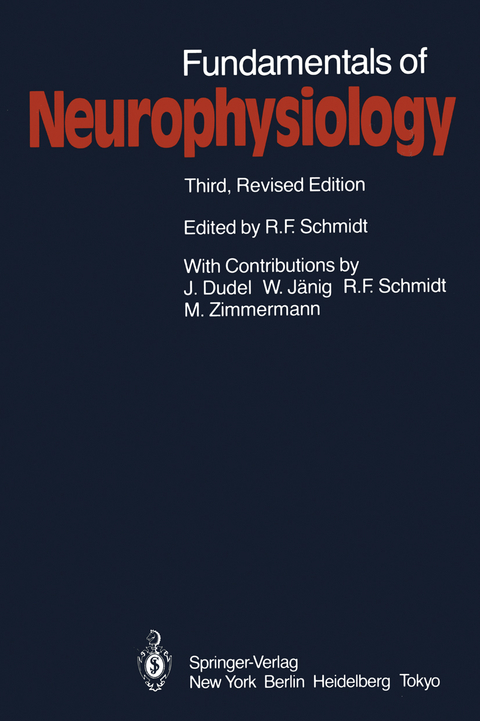
Fundamentals of Neurophysiology
Springer-Verlag New York Inc.
978-0-387-96147-7 (ISBN)
1 The Structure of the Nervous System..- 1.1 The Nerve Cells.- 1.2 Supporting and Nutritive Tissue.- 1.3 The Nerves.- 1.4 The Structure of the Spinal Cord.- 2 Excitation of Nerve and Muscle..- 2.1 Resting Potential.- 2.2 Resting Potential and Na+ Influx.- 2.3 The Sodium Pump.- 2.4 The Action Potential.- 2.5 Kinetics of Excitation.- 2.6 Electrotonus and Stimulus.- 2.7 Propagation of the Action Potential.- 3 Synaptic Transmission..- 3.1 The Neuromuscular Junction: Example of a Chemical Synapse.- 3.2 The Quantal Nature of Chemical Transmission.- 3.3 Central Excitatory Synapses.- 3.4 Central Inhibitory Synapses.- 3.5 The Transmitter Substances at Chemical Synapses.- 4 The Physiology of Small Groups of Neurons; Reflexes..- 4.1 Typical Neuronal Circuits.- 4.2 The Monosynaptic Reflex Arc.- 4.3 Polysynaptic Motor Reflexes.- 5 Muscles.- 5.1 Contraction of the Muscle.- 5.2 Dependence of Force Development on Fiber Length and Velocity of Shortening.- 5.3 Excitation-Contraction Coupling.- 5.4 Regulation of Muscle Contraction.- 6 Motor Systems.- 6.1 Spinal Motor Systems I: Roles of Muscle Spindles and Tendon Organs.- 6.2 Spinal Motor Systems II: Polysynaptic Motor Reflexes; the Flexor Reflex.- 6.3 Functional Anatomy of Supraspinal Motor Centers.- 6.4 Reflex Control of the Posture of the Body in Space.- 6.5 Functions of the Basal Ganglia, Cerebellum and Motor Cortex.- 7 Regulatory Functions of the Nervous System, as Exemplified by the Spinal Motor System..- 7.1 The Stretch Reflex as a Length-Control System.- 7.2 Static and Dynamic Properties of Control Systems.- 8 The Autonomic Nervous System..- 8.1 Functional Anatomy of the Peripheral Autonomic Nervous System.- 8.2 Acetylcholine, Noradrenaline and Adrenaline.- 8.3 Smooth Muscle: Myogenic Activity and Responses to Stretching, Acetylcholine, and Adrenaline.- 8.4 Antagonistic Effects of Sympathetic and Parasympathetic Activity on Autonomic Effectors.- 8.5 Central Nervous Regulation: Spinal Reflex Arc, Bladder Regulation.- 8.6 Genital Reflexes.- 8.7 Central Nervous Regulation: Arterial Blood Pressure, Regulation of Muscle Perfusion.- 8.8 The Hypothalamus. The Regulation of Body Temperature, Osmolality of the Extracellular Fluid, and the Endocrine Glands.- 8.9 Integrative Functions of the Hypothalamus. Limbic System.- 9 Integrative Functions of the Central Nervous System..- 9.1 Structure and General Physiology of the Cerebral Cortex; the Electroencephalogram.- 9.2 Waking, Sleeping, Dreaming.- 9.3 Consciousness and Speech: Structural and Functional Prerequisites.- 9.4 Learning and Memory.- 9.5 The Frontal Lobes.- 10 Suggested Readings.- 11 Answer Key.
| Reihe/Serie | Springer Study Edition |
|---|---|
| Co-Autor | Josef Dudel, Wilfrid Jänig, Robert F. Schmidt |
| Übersetzer | Marguerite A. Biedermann-Thorson |
| Zusatzinfo | 11 Illustrations, black and white; X, 346 p. 11 illus. |
| Verlagsort | New York, NY |
| Sprache | englisch |
| Maße | 155 x 235 mm |
| Themenwelt | Studium ► 1. Studienabschnitt (Vorklinik) ► Anatomie / Neuroanatomie |
| Studium ► 1. Studienabschnitt (Vorklinik) ► Physiologie | |
| Naturwissenschaften ► Biologie ► Humanbiologie | |
| Naturwissenschaften ► Biologie ► Zoologie | |
| ISBN-10 | 0-387-96147-X / 038796147X |
| ISBN-13 | 978-0-387-96147-7 / 9780387961477 |
| Zustand | Neuware |
| Informationen gemäß Produktsicherheitsverordnung (GPSR) | |
| Haben Sie eine Frage zum Produkt? |
aus dem Bereich


